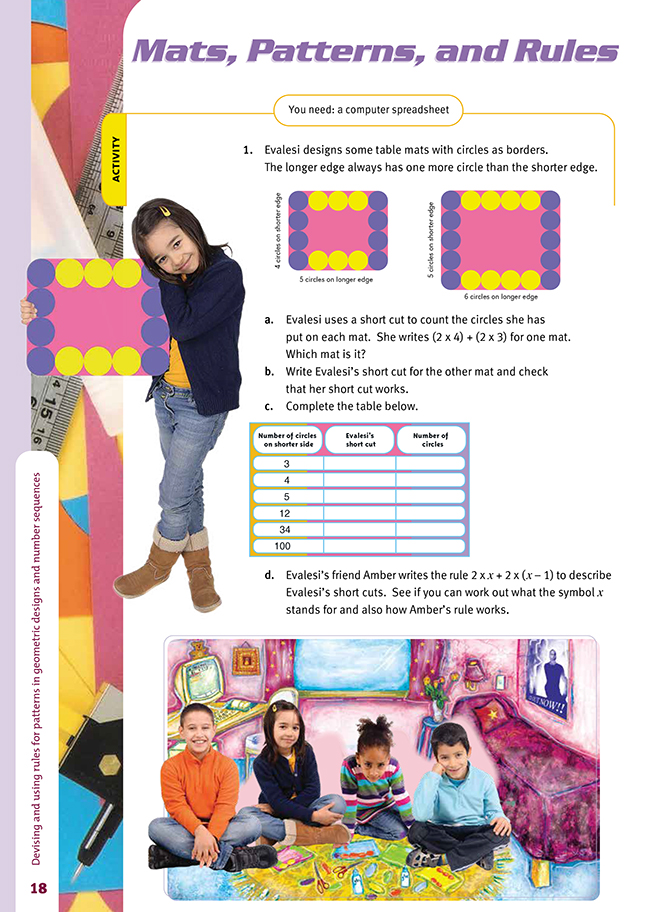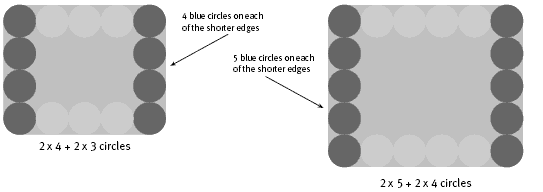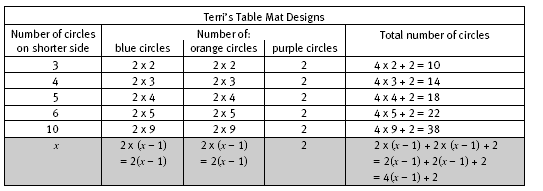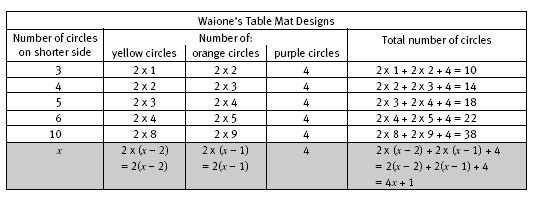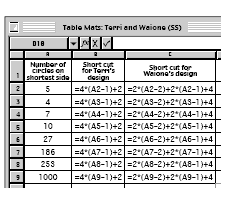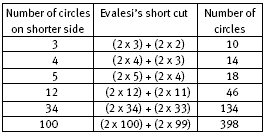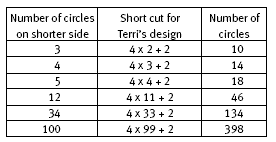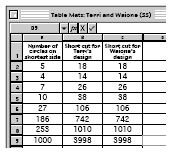This is a level 5 algebra strand activity from the Figure It Out series.
A PDF of the student activity is included.
Click on the image to enlarge it. Click again to close. Download PDF (391 KB)
use a table to find a rule for a geometric pattern
write the rule for a relationship as a linear equation
use rules that describe quadratic relationships
FIO, Level 4+, Algebra, Book Four; Mats, Patterns, and Rules, pages 18-19
computer spreadsheet
In this activity, students devise rules to predict the number of circles on the borders of table mats. In each of the different designs, the longer edge always has 1 more circle than the shorter edge.
In question 1, the students need to use the pattern of coloured circles in Evalesi’s designs to help explain the rule. The two short cuts for calculating the number of circles in the table mats shown are:
The pattern in these two short cuts suggests that a design with 6 circles on the shorter edge will have 2 sets of 6 blue circles and 2 sets of 5 yellow circles, that is, 2 x 6 + 2 x 5 = 22 circles altogether. A table showing how Amber’s rule can be derived from the short cuts for Evalesi’s designs is given in the Answers. Looking at the calculations in this table, it is clear that the x in Amber’s rule is the number of circles on the shorter edge of the table mat. The last row in the table below shows how the rule is formed.
The short cuts leading to the algebraic rules for the designs in question 2 are shown in the tables below.
In question 2c, the formula in cell B2 is =4*(A2–1)+2. The value in cell A2 is 5, so the formula calculates 4 x (5 – 1) + 2 = 18. In cell B3, the formula will be =4*(A3–1)+2, which calculates 4 x (4 – 1) + 2 = 14. And in cell B9, the formula =4*(A9–1)+2 calculates 4 x (1 000 – 1) + 2 = 3 998 because the value in cell A9 is 1 000. The formulae in the active cells in column B can all be represented by the algebraic rule 4(x – 1) + 2, where x stands for the number of circles on the shorter side of any table mat.
The rule that describes Waione’s design pattern is 2(x – 2) + 2(x – 1) + 4. So the formula that goes in cell C2 is =2*(A2–2)+2*(A2–1)+4. The formula that goes in cell C3 will be =2*(A3–2)+2*(A3–1)+4 and, in cell C9, the formula will be =2*(A9–2)+2*(A9–1)+4. The value in cell A9 is 1 000, so the formula in cell C9 alculates 2 x 998 + 2 x 999 + 4 = 3 998. Note that this value is the same as that calculated for cell B9 above.
The spreadsheet below shows the formulae for the spreadsheet for question 2c iii. The spreadsheet given in the Answers shows the values calculated by the formulae.
In question 3, Evalesi notices that each short-cut answer is 4 times the number of circles on the shortest side minus 2. Evalesi’s rule is therefore 4 x x – 2, or 4x – 2. By choosing any value of x from the spreadsheet, the
students will find that = 2. (The calculations for the case in which x = 7 are given in the Answers.)
Note that the algebraic rules given earlier for the designs for Evalesi, Terri, and Waione all simplify to 4x – 2, as shown in the Answers.
Answers to Activity
1. a. The smaller table mat. (It has 4 + 4 blue circles and 3 + 3 yellow circles, which is the same as (2 x 4) + (2 x 3) circles.)
b. (2 x 5) + (2 x 4) = 18 circles. It has 5 + 5 blue circles and 4 + 4 yellow circles.
c.
d. The x in the rule 2 x x + 2 x (x – 1) represents the number of circles in the shorter side of any of Evalesi’s table mat designs. So x can stand for 3, 4, 5, 12, 34, 100, and, in fact, any number.
2. a. i. Terri’s design has 2 x 4 blue circles, 2 x 4 orange circles, and two purple circles. So there are 2 x 4 + 2 x 4 + 2 circles altogether, which is 4 x 4 + 2.
ii.
iii. When there are any number (x) of circles on the shorter side of a table mat with Terri’s design, there are 2 x (x – 1) blue circles, 2 x (x – 1) yellow circles, and 2 purple circles. So there are 2 x (x – 1) + 2 x (x – 1) + 2 circles altogether. This is 4 x (x – 1) + 2, or 4(x – 1) + 2.
b. A possible rule is: 2(x – 2) + 2(x – 1) + 4. When there are any number (x) of circles on the shorter side of a table mat with Waione’s design, there are 2 x (x – 2) yellow circles, 2 x (x – 1) orange circles, and 4 purple circles. So there are
2 x (x – 2) + 2 x (x – 1) + 4 circles altogether.
c. i. The value in cell A2 is 5. So the formula 4*(A2–1)+2 calculates 4 x (5 – 1) + 2 = 18. Waione’s short cut when x = 5 is 2 x (5 – 2) + 2 x (5 – 1) + 4, which can be
simplified to 4 x (5 – 1) + 2. So the spreadsheet formula is the same as Waione’s
version of the algebraic rule.
ii. A formula based on the rule given in b is: =2*(A2–2)+2*(A2–1)+4
iii. The spreadsheet should look like this:
3. a. 2. In this rule, x stands for the number of circles on the shorter side of any of the mat designs. So, for example, when x = 7, 4 x x – = 26 becomes 4 x 7 – = 26. This is 28 – = 26, so the value in the box is 2. Evalesi’s rule is therefore 4 x x – 2, or 4x – 2.
b. i. 2 x x + 2 x (x – 1) = 2 x x + 2 x x – 2 x 1
= 2x + 2x – 2
= 4x – 2
ii. 4 x (x – 1) + 2 = 4 x x – 4 x 1 + 2
= 4x – 4 + 2
= 4x – 2
iii. 2 x (x – 2) + 2 x (x – 1) + 4
= 2x – 4 + 2x – 2 + 4
= 2x + 2x – 4 – 2 + 4
= 4x – 2
